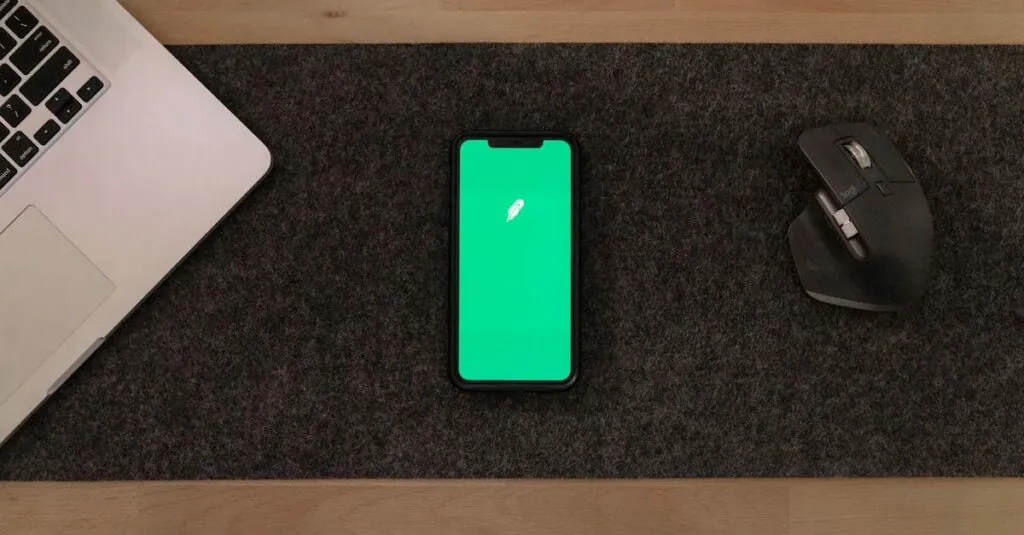Choosing the right laptop can feel like picking a favorite child, especially for architecture students. With demanding software and a need for portability, it’s crucial to find a machine that won’t just survive all-nighters but thrive during them. After all, the last thing anyone wants is a laptop that crashes mid-presentation, leaving them to explain why their masterpiece turned into a digital ghost.
Table of Contents
ToggleOverview of Laptops for Architecture Students
Architecture students require laptops that meet specific performance standards. Reliability ranks high on the list, as students often work on intricate designs and simulations. Portability also plays a crucial role since students frequently move between classrooms, studios, and workspaces.
Graphics capability significantly influences the choice of a laptop. Many architecture programs rely on demanding software like AutoCAD, SketchUp, or Revit. Selecting a laptop with a dedicated graphics card ensures smooth rendering and editing processes.
Processor speed cannot be overlooked. A strong multi-core processor facilitates efficient multitasking and quick loading times, which are vital during project crunch times. Look for laptops equipped with at least an Intel i7 or AMD Ryzen 7 for optimal performance.
RAM size directly affects how smoothly programs run. Ideally, a laptop should have a minimum of 16 GB RAM to handle large files and multiple applications simultaneously. This capacity allows for effective project management without frustrating delays.
Battery life remains an important consideration too. Architecture students often work long hours, necessitating laptops that can last through extended studio sessions. Laptops that offer at least 10 hours of battery life provide the flexibility needed for uninterrupted work.
In addition to hardware specs, design weight and durability also matter. Lightweight models make transportation easier, while sturdy builds can withstand daily wear and tear. Selecting a laptop that balances these features enhances the overall student experience, allowing for focus on design rather than technical issues.
Choose a laptop that aligns with personal needs and the specific requirements of architectural coursework. Prioritizing performance, portability, and durability leads to a more effective learning environment.
Key Features to Consider
Architecture students need to prioritize specific features when selecting a laptop to ensure seamless workflow and productivity.
Processing Power
A strong processor is vital for running demanding software efficiently. Intel i7 and AMD Ryzen 7 are preferred choices for architecture students. They enable smooth multitasking, which is crucial when working on multiple applications simultaneously. Quick loading times enhance productivity and reduce frustration. Students frequently deal with complex models and large files, making multi-core processing essential for performance. It’s important to choose a machine with at least four cores to manage software effectively.
Graphics Performance
A dedicated graphics card significantly impacts the ability to run computer-aided design programs. NVIDIA GeForce GTX or RTX series and AMD Radeon graphics cards are recommended for optimal performance. These graphics cards handle 3D rendering and visualization tasks with ease. Architectural software like AutoCAD and Revit benefits from robust graphics capabilities. Investing in a laptop with a powerful GPU ensures a smoother workflow when creating intricate designs and presentations.
Display Quality
High-resolution displays enhance the visual experience for architecture students. A minimum Full HD (1920 x 1080) resolution is suitable for detailed work. Many students also prefer screens with accurate color reproduction, as this aspect is essential for visual presentations. IPS panels provide wider viewing angles and better color consistency, which proves beneficial during collaborative work. A larger screen size, ideally 15 inches or above, facilitates working on intricate details without strain.
Battery Life
Long battery life is a necessity for architecture students who often work on the go. A minimum of 10 hours ensures coverage for extended studio sessions. Quick charging capabilities also reduce downtime during long study hours. Students appreciate the flexibility to move between classrooms or studios without worrying about power sources. Opting for laptops with efficient power management optimizes performance while conserving battery life.
Top Laptop Recommendations
Selecting the right laptop can significantly enhance the architectural design experience. Here are three top laptop recommendations tailored for architecture students.
Laptop 1: Specifications and Benefits
Dell XPS 15 stands out for its powerful performance and sleek design. Equipped with an Intel i7 processor, this laptop ensures smooth multitasking alongside demanding software like Revit and SketchUp. It features a dedicated NVIDIA GeForce GTX graphics card, ideal for 3D rendering. With 16 GB RAM, this laptop manages large files effortlessly. A stunning 15.6-inch 4K display offers vibrant colors and sharp details, crucial for precise work. Battery life of up to 12 hours supports long studio sessions without interruption. Lightweight construction makes transportation easy for daily commutes.
Laptop 2: Specifications and Benefits
Apple MacBook Pro 16 is highly regarded for its exceptional build quality and performance. This model operates on an M1 Pro chip, providing efficient processing power for architecture applications. Featuring a dedicated GPU, it excels at heavy graphics tasks and 3D modeling. Ample 16 GB RAM ensures seamless operation across multiple apps. With a 16-inch Retina display, students enjoy crisp visuals and true-to-life colors. Battery endurance reaches around 14 hours, making it perfect for extended use. Built with durability in mind, this laptop withstands the rigors of an architectural student’s lifestyle.
Laptop 3: Specifications and Benefits
ASUS ROG Zephyrus G14 delivers high performance in a compact design. This laptop utilizes an AMD Ryzen 9 processor for superior speed and multitasking capabilities. A dedicated NVIDIA GeForce RTX 3060 graphics card supports advanced architectural software effortlessly. It offers a minimum 32 GB RAM, accommodating resource-heavy applications with ease. Displaying vibrant graphics on a 14-inch Full HD screen ensures clarity for detailed designs. Battery life provides around 10 hours of use, ideal for busy school days. Portability complements its sturdy build, making it suitable for on-the-go students.
Budget Options for Architecture Students
Finding budget-friendly laptops that meet the demands of architecture students is essential. Consider options that provide solid performance without stretching finances.
Acer Aspire 5 stands out for its affordability and robust specs. It features an AMD Ryzen 5 processor, 8 GB RAM, and a dedicated NVIDIA GeForce MX250 graphics card. The 15.6-inch Full HD display enhances detail visibility during projects. Battery life of approximately 8 hours is suitable for class and studio use.
Asus VivoBook 15 offers a well-rounded performance for a lower price. A vibrant 15.6-inch Full HD screen complements its Intel i5 processor and 16 GB RAM. The included NVIDIA GeForce MX330 graphics card supports moderate rendering tasks. Battery life nearing 7 hours ensures it lasts through long study sessions.
Lenovo IdeaPad 3 provides versatility at a reasonable cost. The laptop’s AMD Ryzen 5 processor and 12 GB RAM handle various applications efficiently. Its 14-inch Full HD display strikes a balance between portability and usability. With about 9 hours of battery life, it serves students well during demanding days.
HP Pavilion 15 also merits mention among budget-friendly choices. An Intel i5 processor, 8 GB RAM, and AMD Radeon graphics efficiently run architecture software. Its 15.6-inch Full HD display contributes to an engaging design experience. Battery life of 10 hours allows ample time for projects and presentations.
These options cater to architecture students aiming to balance quality and affordability. Prioritizing performance, battery life, and display quality ensures a satisfactory experience in educational pursuits. Select a laptop that aligns with specific needs and academic requirements for optimal learning.
Choosing the right laptop is crucial for architecture students navigating their demanding coursework. By prioritizing performance portability and durability they can ensure a smoother learning experience. With powerful processors dedicated graphics cards and ample RAM students can tackle complex software with ease.
Additionally selecting a model with a high-resolution display and solid battery life can enhance productivity during long studio sessions. Students should consider their specific needs and budget while exploring the recommended options. Ultimately the right laptop will not only support their academic journey but also empower their creative potential in the field of architecture.





